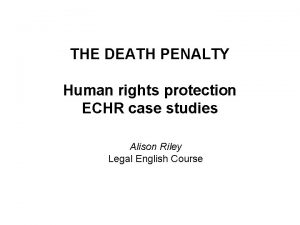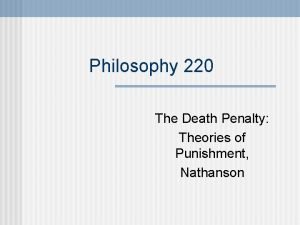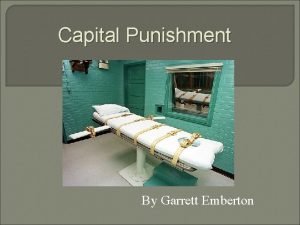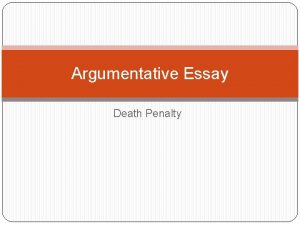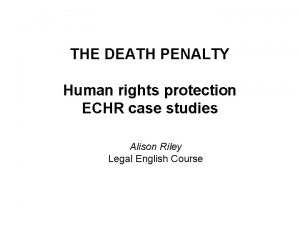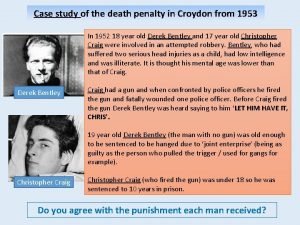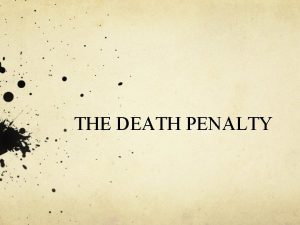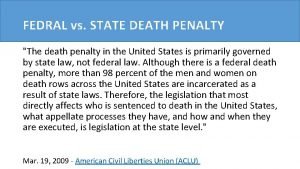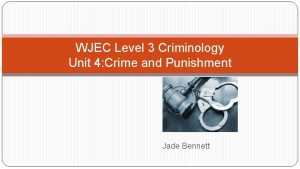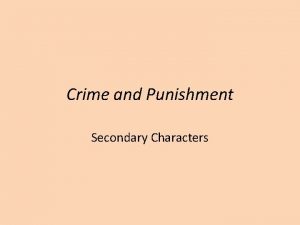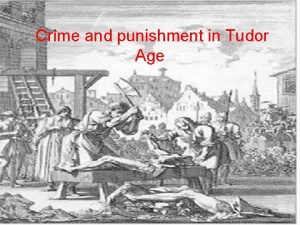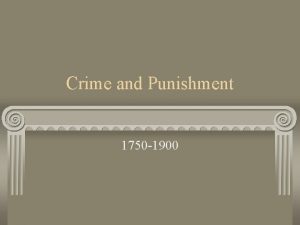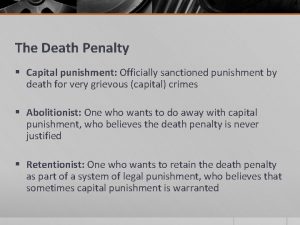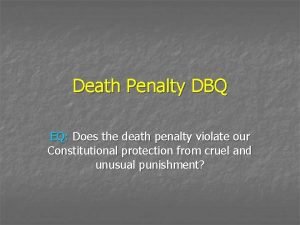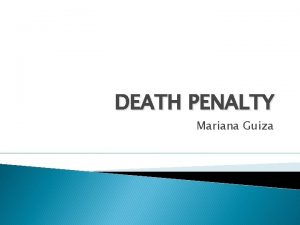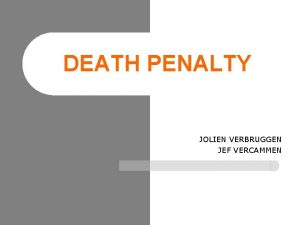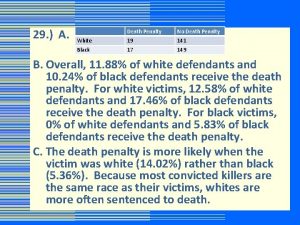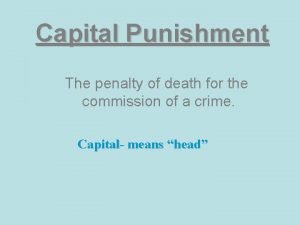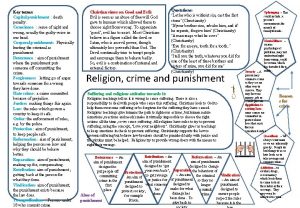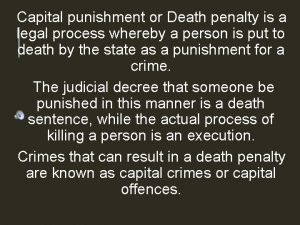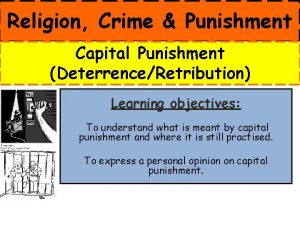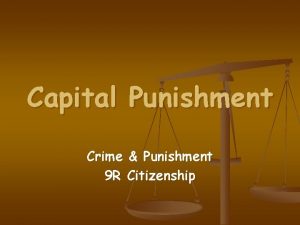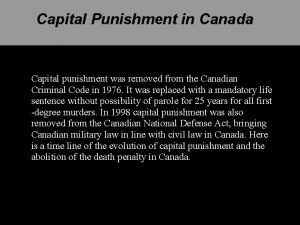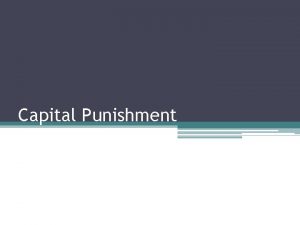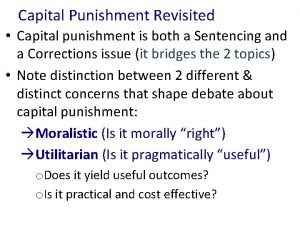THE DEATH PENALTY Capital Punishment Definition A crime























- Slides: 23

THE DEATH PENALTY

Capital Punishment Definition: A crime punishable by death. Example: In some countries, importing drugs is capital offence. 139 countries have the death penalty

Capital Punishment At least 20 countries were known to have carried out judicial executions in 2011. At least 676 executions were carried out in 2011. Countries with the Most Confirmed Executions in 2011 1. China (1, 000 s *) 3. Saudi Arabia (82+) 5. U. S. (43) Source: Amnesty International 2. Iran (360+) 4. Iraq (68+) 6. Yemen (41+)

Methods used § Hanging § Crucifixion § Stoning § The guillotine § Burning at the stake § The gas chamber § Pressing or crushing § Firing squad § Electrocution § Lethal injection

Capital Offences in the U. S Premeditated Murder f o s e m o S e s u ca e p ra Kid napp Es pio ing na ge Treason 38 states in the U. S. have chosen to keep the death penalty

Capital Punishment in Canada Capital punishment was enacted in 1859 • All murder convictions, prior to 1961, resulted in execution. • After 1961, a murder charge was divided into capital and non-capital offences such as: 1. Planned or violent killings 2. The murder of police officers and prison guards.

Capital Punishment in Canada 710 individuals were executed between 1859 until 1976, when capital punishment was abolished

Sentences for Murder in Canada 1. First Degree Murder: Murder Life Sentence with no. possibility of parole for 25 years 2. Second Degree Murder: Murder Life sentence with no possibility of parole for at least 10 years 3. Manslaughter: Manslaughter Life sentence with parole eligibility after 7 years

Where do you stand on capital punishment? Are you for or against it? Remember: Every argument has two sides.

Canadian Perspective Economic Justification: The death penalty costs far more than life in prison. Why? Investigative costs Costs can start prior to the trial. i. e. Pre-trial jury selection More court time results in more fees. i. e. Two phases to a death penalty trial. 1) conviction and 2) sentencing Using conservative rough projections, the Commission estimates the annual costs of the present system ($137 million per year), the present system after implementation of the reforms. . . ($232. 7 million per year). . . and a system which imposes a maximum penalty of lifetime incarceration instead of the death penalty ($11. 5 million). " --California Commission on the Fair Administration of Justice, July 1, 2008

Canadian Perspective DNA Justification: DNA is available in no more than 10% of murder cases. It is not a miracle cure for sentencing individuals to death It is human nature to make mistakes and DNA research is still improving.

Canadian Perspective Deterrence The death penalty is not a deterrent Canada’s murder rate is 1/3 of the U. S. Murder rates in Canada have been decreasing since the mid-1970 s. Murder rate in Canada per 100, 000 3. 0/100000 in 1970 s vs. 1. 8/100000 present day

Canadian Perspective Social Aspect : Possibility of executing an innocent person Over 120 people on death row have been released with evidence of their innocence. Many have served 2 decades in prison on death row Time is needed to prove innocence Closing a case with an execution of an innocent person could mean a criminal got a way with murder

THE DEATH PENALTY The INNOCENT and the GUILTY

Steven Truscott – age 14 Many people believe that the Steven Truscott case led the Canadian justice system to abolish capital punishment in 1976. At age 14 he was accused of murdering a classmate (1959).

Steven Truscott today You. Tube - Steven Truscott Case - updated version

Steven Truscott Acquitted Steven was acquitted of the murder of Lynne Harper His conviction pronounced a miscarriage in justice in the courts 300 page decision Ontario Attorney General Michael Bryant held a news conference to apologize to Steven, who spent 80% of his life as a convicted murderer

David Milgaard In 1970, 16 -year-old David Milgaard was sentenced to life imprisonment for the 1969 murder of 20 -year-old Saskatoon nursing aide Gail Miller. After 23 years in prison, the Supreme Court of Canada set aside his conviction. Five years later he was cleared by DNA evidence and awarded $10 million. In the same year, Larry Fisher was found guilty of the rape and stabbing death of Gail

Guy Paul Morin Convicted of 1984 murder and rape of 8 -year old neighbour, Christine Jessop. Cleared by DNA testing. Incompetence and mistakes by the police, prosecutors and forensic scientists combined to send an innocent man to jail.

Donald Marshall A Mi’kmaq Indian (Nova Scotia), he was convicted in 1971 of killing his friend. Spent 11 years in jail. An inquiry pointed to racism within the justice system that led to the wrongful conviction of Marshall.

Paul Bernardo & Karla Homolka The Ken and Barbie Killers Raped and killed 3 girls including Karla’s sister. She made a deal with the police and got 12 years in prison. He got life.

Clifford Olsen Serving life sentence for the rape and murder of 11 children. Arrested 1981. Made a deal with the authorities: his family received $100, 000 for his cooperation with the police. He led them to the graves of the children he murdered.

Questions to consider/research: How many prisoners on parole commit murder again? How often is DNA evidence used? Is DNA evidence infallible Should the criminally insane killer be executed? How many aboriginal and black prisoners are in prison? Should religious beliefs influence Canadian law?
 Ernest van den haag
Ernest van den haag Echr death penalty
Echr death penalty Nnn punishments
Nnn punishments Thesis statement about the death penalty
Thesis statement about the death penalty Argumentative essay about death penalty
Argumentative essay about death penalty Echr death penalty
Echr death penalty Middle ground death penalty
Middle ground death penalty Death penalty
Death penalty Death penalty case study
Death penalty case study Heretic fork
Heretic fork Capital punishment definition
Capital punishment definition Capital punishment definition
Capital punishment definition Capital punishment definition
Capital punishment definition Criminology unit 4 crime and punishment
Criminology unit 4 crime and punishment Crime and punishment revision guide
Crime and punishment revision guide Who is razumikhin
Who is razumikhin Tudor whipping
Tudor whipping Criminology unit 4 wjec
Criminology unit 4 wjec Plagiarism crime punishment
Plagiarism crime punishment Medieval crime and punishment facts
Medieval crime and punishment facts Gcse history past papers edexcel
Gcse history past papers edexcel Kahoot crime and punishment
Kahoot crime and punishment Crime and punishment in medieval japan
Crime and punishment in medieval japan Crime and punishment 1750 to 1900
Crime and punishment 1750 to 1900

